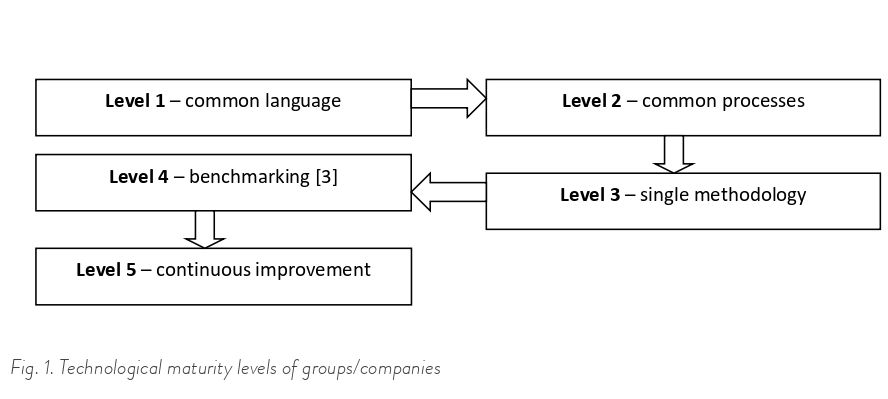
THE STRATEGY OF UkrISTEI IN THE IMPLEMENTATION OF INOVATIVE PROJECTS IN THE FIELD OF TECHNOLOGY TRANSFER
Abstract
Introduction
The introduction of scientific developments and already finished products requires the involvement of specialists from various fields of production. An important point in this collective work is the creation of so-called interstate network support groups for the presented process. The essence of its work is as follows: imagine a situation where separate scientific and business units have a common goal. To achieve it, they develop a strategy for achieving this goal, and ways to solve individual issues. Since each of the members of this network group represents a separate area of economic activity, they can provide their services to other members of this group in order to achieve the general goal already mentioned above.
Methodology
Any collectively created project requires a clear execution script. Each member of the interstate network support group works within the framework of the implementation of a specific innovative project in the field of technology transfer support. It is clear that for fruitful work within the group, it is necessary to create a favorable atmosphere. And for this, it is also necessary to adhere to the minimum needed conditions for increasing the efficiency of the work of the interstate network technology transfer support group, as well as any team in general. The main method that was used in the process of preparing this work was the system-analytical method. With its help, the basic features of the scientific activities of the structural divisions of UkrISTEI were considered, the main results were summarized, and general recommendations were presented.
Purpose
The main purpose of the scientific article is to identify measures to improve the efficiency of the work of interstate network technology transfer support groups that can be used by other specialized organizations. The research is based on the analysis of a network group created at UkrISTEI based on the Department of International Scientific and Technical Cooperation and Technology Transfer, which is the so-called “core” of the group, and the Department employees are its permanent members.
Results
The main goal for every scientist is the desire to evaluate the effectiveness of his work, to identify the level of usefulness of the results of his activities for users. Thus, the authors of the article tried to summarize the data in assessing the effectiveness of the work of the interstate network technology transfer support group, which operates on the basis of an Automated system for the formation of integrated interstate information resources (ASFIMIR) [1], highlighting the main measures to increase the level of efficiency in order to improve the work in the future.
The assessment of the effectiveness of the functioning of the interstate network technology transfer support group was carried out by the authors according to the model of technological maturity. American scientist, Ph.D. Harold Kerzner, identified the general phases that groups/companies go through as they develop and improve. This model is called “a model for assessing the technological maturity of groups/organizations in project management (including in the field of technology transfer)” – (РМММ – Project Management Maturity Model) [2].
The authors of the article tried to adapt this model to the activities of the interstate network technology transfer support group at UkrISTEI. Schematically, Harold Kerzner’s Project Management Maturity Model (PMMM) is shown in Figure 1.

As mentioned above, the ASFIMIR system has been created and is successfully operating at UkrISTEI. It is a base, a working platform for the functioning of the group, its main tool used by permanent members of the group – employees of the department– in order to find new contacts, exchange information with potential partners and clients. All this time, the ASFIMIR system has been constantly improving, changing, and integrating into new networks and systems, as required by the challenges of the modern scientific world. After the successful implementation of a number of scientific projects (interstate agreements), an idea to create an interstate network technology transfer support group on the basis of the ASFIMIR system to implement innovative projects in the field of technology transfer arose. In 2016, it was decided to give it an official status – to develop documentation: technological regulations, technical description, determine a clear distribution of functions, rights and obligations. In 2016, a joint Ukrainian-Belarusian scientific project together with the Republican Center for Technology Transfer (RCTT) “Construction of the Ukrainian-Belarusian segment of the information technology platform for the transfer of technologies for collective use based on automated resource generation systems of UkrISTEI and RCTT” was started
G. Kerzner’s model provides for a framework distribution of levels according to mathematical calculations, using a point system. However, the peculiarity of the interstate network technology transfer support group of the ASFIMIR system lies in its universality, adaptability, flexible boundaries. Therefore, based on the data shown in Fig. 1, the following characteristics of the functioning of typical network groups in the field of technology transfer can be distinguished (some of these characteristics partially or to some extent correspond to the interstate network technology transfer support group based on the ASFIMIR system):
Level 1 – the presence of a common language in the team. The result should be finding their place in the group by each of its participant, establishing a favorable, friendly atmosphere in the team.
At this stage, the first “acquaintance” of the members of the future network group takes place. If specialists already familiar with each other become members of the group, then the process of adaptation of the group members takes place quite quickly.
In the Department of International Scientific and Technical Cooperation and Technology Transfer, this stage took place according to the second scenario: the backbone of the group was formed from specialists who had already worked in one institution for quite a long time. Therefore, the process of finding a common language and, as a result, determining the level of basic knowledge in the organization of the group went naturally and almost imperceptibly. Regarding the involved specialists (whose participation is necessary for accordance with the requirements of each individual project), the process of adaptation and search for a common language takes a little longer.
Level 2 – common processes. The result should be the beginning of joint work; activities aimed at the initial steps towards achieving the goal.
At this stage, a single plan/scheme for carrying out work toward the implementation of the goal is created. Such a plan is submitted for consideration to the management of the institution/organization, or to the authorized body/person. A prerequisite is consent to perform work according to this plan from the customer – technology/product developer, investor, interested person.
Based on the results of the work performed at the beginning of 2017, in the sector of information support for technology transfer, a draft regulation was developed for the functioning of the interstate network group, indicating the basic principles of work of the group members: functions, rights, obligations, etc.
Level 3 – single methodology. The result should be initial assessments of the work of the group in the direction of the implementation of the given project.
At this stage, the group already has experience in fulfilling the set goals, and algorithms have been created for performing certain basic tasks/functions. The group already has a wide range of useful contacts that may be useful in the course of other projects. It is at this level that it is useful to start openly advertising your activities – to share your results, positive experience. In 2018, a joint project “Creation of the Ukrainian-Chinese Center for Scientific and Technical Information on the basis of the Interstate Information Technology Platform for Collective Use in the formation of an electronic resource by new scientific and technical achievements and high technologies of Ukraine and the People’s Republic of China| was started. The partner in the project – the Institute for Research on Strategies for the Development of Science and Technology of the Xinjiang Uyghur Autonomous Region (PRC), Uruchmi.
Considering that the ASFIMIR system has long established itself in the domestic scientific space as a competitive technology transfer support system, the need for targeted advertising of the group’s achievements is not in itself a priority. However, the members of the group still continue to work to inform stakeholders about the results of their activities in order to attract new potential customers and partners.
Level 4 – benchmarking. The result – bringing to a qualitatively new level of professional activity of the network group.
For more efficient benchmarking, it is desirable to create separate units for this activity. Benchmarking is based on the process of finding an ideal and cost-effective competitor company in order to compare it with your own and adopt its best working methods. That is, this work is constant and continuous; searching and evaluating the activities of other similar groups/organizations/enterprises takes a lot of time, however, such activities bring positive results – in the form of mastering positive experience for one’s own work.
The specifics of the work of the Department of information support for technology transfer of UkrISTEI lies in the constant improvement of the process of technology transfer. Its essence is to monitor technology transfer networks similar to the ASFIMIR system, analyze their activities, compare and search for common and distinctive features in systems. Therefore, benchmarking is already a familiar process for Department employees. It can be stated that this level is not pronounced in the functioning of the network group in UkrISTEI.
Level 5 – continuous improvement. The result is the accumulation of successful technology transfer projects, the dissemination of our experience. This condition is valid if the goal set by the group is achieved.
At this stage, it is already possible to disseminate information about the achievements of the group on a paid basis: conduct trainings, seminars, courses, give lectures, train employees and representatives of other institutions in the specifics of activities. In 2019, an Agreement on partnership and cooperation between UkrISTEI and the Slovak Centre of Scientific and Technical Information was signed; joint work on the implementation common goals in the sphere of the technology transfer.
However, the implementation of this item is not yet in the plans of the interstate network group based on UkrISTEI. The accumulated experience is still not enough to present to the general public. However, given the very short period of the official functioning of the group, it can be stated that mentoring activities will be relevant after a certain period of time.
Combining the analyzed above information, as well as the experience of the network group on the basis of the Department of International Scientific and Technical Cooperation and Technology Transfer, it is possible to single out certain problems of network groups during implementing projects in the field of technology transfer: low organizational efficiency of staff; the inability to distribute working time for normal activities and work with innovative implementations in the field of technology transfer; the requirement of high professional competence of employees at all levels of group management, as well as a high level of corporate culture between them. In addition, the requirements for the level of remuneration of employees-members of the network group are increasing (in this case, resistance is often encountered from the management of the institution/governing body of the group), and there is also the problem of monetary rewards for the attracted members of the group. These problems are relevant for the group based on UkrISTEI.
So, the result of the study was generalized measures to improve the efficiency of the functioning of the interstate network technology transfer support group, as well as other similar network groups/structures:
1. In an ideal situation, it is recommended to start the activities of the interstate network technology transfer support group from the development of the rules for the activities of the group, which should contain information about: the main provisions, the features of the group’s activities, the obligations and rights of the members of the group, special conditions and exceptional aspects in the work of the network group, etc.
2. It is important at the initial stage to create a body that would be responsible for the activities of the group. This can be either the management of the institution on the basis of which the group was created (if it exists within the same organization), or a certain authorized body (if the members of the group are employees of different institutions or even countries). The responsible representative can also be an individual (customer of the service – developer, investor, etc.), or another interested person (such a condition requires a small group size and an appropriate level of projects to be completed).
3. Together with the definition of the responsible body/person for the activities of the interstate network group, an important stage is the creation of the main/project office of the group. This concept includes not so much a building or a room, but a base that would integrate all existing project management methods in the field of technology transfer into a single integrated methodology. Taking into account the existing experience of the network group on the basis of the Department of International Scientific and Technical Cooperation and Technology Transfer and the state of affairs at the moment, it is this structural component of the institute that is the main office for managing the group’s activities, and the sector’s employees are permanent members of the network group.
4. It is desirable to avoid large-scale regulation (bureaucratic documents, acts, other official papers) through the introduction of automation of management and systematization of processes and the introduction of verified group work algorithms. A large number of unnecessary papers slows down the work of network team members; it is important to limit yourself to a minimum number of regulatory documents.
5. At a certain stage, the participants of the network group will have the first positive results from the implementation of projects in the field of technology transfer. It is important that the experience of acquiring such results be used for its intended purpose, namely, used by this group in the implementation of the upcoming tasks, and by other groups, as a result of the dissemination of positive experience of their activities. The optimal option for storing information about successful projects in the main/project office of the network group should be chosen.
6. The experience of unsuccessful projects is also a very rewarding experience. It should be taken into account during work. Therefore, it is recommended to create a so-called “archive” of unfinished or even unsuccessful projects that have not reached their logical conclusion, or that had a number of failures and errors in the execution process. The accumulation and analysis of such information will help to avoid or minimize similar failures in the future.
7. An important component of the functioning of the network group is its budget. Centralized planning of financial activities is an integral part of the work during the implementation of projects in various fields, including in the field of technology transfer. Typically, the financial planning function is performed by the accounting department. In the activities of interstate network groups, this work can also be performed by the accounting department or a specially authorized body. The accountant can also be an involved member of a network team for a specific technology transfer project.
8. Pay great attention to the process of benchmarking – the continuous systematic search and implementation of best practices that will lead the group to a better shape. Benchmarking may seem similar to competitive intelligence, although in fact, it is a more detailed and structured tool than conventional competitive intelligence. In addition, benchmarking is an absolutely legal activity, so it is undesirable to neglect its results.
9. Increasing the possibility of self-realization of permanent members of the network group. Development and implementation of the internal innovation system. Through internal improvement, group members improve the level of performance of their professional duties, and therefore the level of implementation of projects in the field of technology transfer.
10. An important place in the work of network groups is played by the level of corporate culture in the team. With a pleasant microclimate between the permanent members of the staff and other members of the group, favorable conditions are created for the performance of their direct duties. Competition between group members should also be avoided. However, motivated competition is very often beneficial for professional development.
Conclusion
The result of the analysis of the activities of interstate network technology transfer support groups was the allocation of measures to improve the efficiency of the work of such groups to support technology transfer. There can be many such events – they will differ only based on the features of the functioning of a particular network group. Therefore, the above measures can be used by specialists not only in the field of technology transfer, but also in other similar groups/structures with a similar structure of functioning. And all of them are aimed at one goal – to increase the professional level of each individual participant and the network group itself as a whole. After all, the algorithm “professional provision of services increases the level of demand for them and increases the area of advertising coverage” is more relevant today than ever. It is clear that such measures are very conditional, but they allow you to create a certain idea about the participants of the interstate network group for the implementation of innovative projects in the field of technology transfer and provide specific recommendations to improve the efficiency of the functioning of interstate network groups, in particular, to support technology transfer.
References:
- Automated System for the Formation of Integrated Interstate Information Resources (ASFIMIR) (2014). State Scientific Institution “Ukrainian Institute of Scientific and Technical Expertise and Information”. Available at: http://store.uintei.kiev.ua/transfer/ua/pages/asfimir.html (Accessed: February 14, 2023).
- Grobler, P., Steyn, H. (2006). Project Management Maturity Models: Does One Size Fit All? Growth and Collaboration for a Project Management Profession, Vol. 1, 10 P.
- What Is Benchmarking in Business? (2022). The Balance. Available at: https://www.thebalancemoney.com/overview-and-examples-of-benchmarking-in-business-2275114 (Accessed: February 14, 2023).
Il. title foto: Pixabay
Iryna Balanchuk

Iryna Balanchuk is the Head of the Department of International Scientific and Technical Cooperation and Technology Transfer, State Scientific Institution „Ukrainian Institute of Scientific and Technical Expertise and Information“ (Kyiv, Ukraine). Since 2011, she carries out international scientific and technical projects within the framework of scientific cooperation with European states. In 2022, under her leadership, the implementation of the research work „Cross-border and international cooperation in scientific, technical and innovation fields: monitoring, analysis, implementation“ was launched. In 2023, this work continues.
ORCID: https://orcid.org/0000-0002-5179-7350
Olena Mikhalchenkova

Olena Mikhalchenkova is the administrator of the Technology Transfer Center, State Scientific Institution „Ukrainian Institute of Scientific and Technical Expertise and Information“ (Kyiv, Ukraine). Since 2007, she works to strengthen cooperation between Ukraine and European and Asian partners in the field of science, innovation and business. Since 2020, she has signed a number of agreements on international partnership in the sector of information support and commercialization of the Ukrainian developments and technologies.
 EN
EN